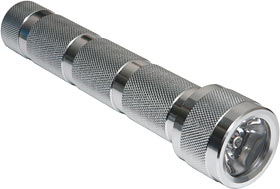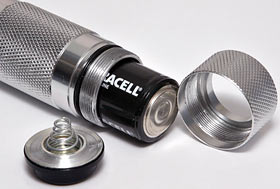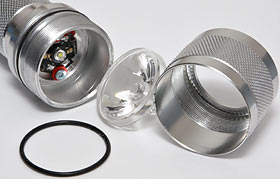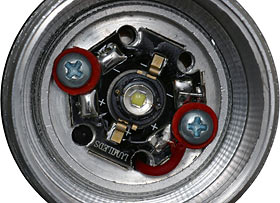
Elektro Lumens FT-3C LED flashlight
Review date: 10 April 2004.Last modified 03-Dec-2011.
When appropriate friends drop by and it's time for Dan's Gadget Show And Tell, I like to point out the ever-increasing amount of light you can get out of one LED, these days.
A single 5mm LED backed by a step-up voltage converter beats the heck out of the weedy incandescent bulbs that used to be the best you could get in a AA- or AAA-battery flashlight, but that's not where the action is any more. Today, larger "super-LEDs" compete impressively with the incandescent bulbs in regular sized home flashlights.
The super-LEDs I show off are all Lumileds Luxeon products. There are other ultra-LEDs on the market today, but Lumileds continue to make the best and brightest, if not the cheapest. Luxeon-LED flashlights used to be oddities, but lots of companies sell them now.
Almost all of the world's Luxeon-LED flashlights use a single one watt Luxeon Star (the "Star" part means the LED emitter comes pre-installed on one of Lumileds' distinctive little hexagonal heat sink circuit boards) as their lamp. The optics in front of the Star vary (from the compact standard lens of Luxeon's "Star/O" to the bigger, better custom-built Fraen lenses), as does the electronics behind it and the amount of heat sinking it gets (incandescent bulbs are happy to run hot; LEDs aren't), but the basic design is the same.
The one watt Star is an excellent light source, which is why so many hobbyists fell upon it before you could get many commercial Luxeon flashlights. Some hobbyist efforts were more practical than others, but Elektro Lumens soon emerged as a front-runner in the hobby-as-business field.
Elektro Lumens started out modifying Mag-Lites, then moved up to an OK custom-made Luxeon chassis, and then to the Blaster series. I like the Blaster III I reviewed a lot. It's really professionally made, it's rock solid, it gives you an adjustable flood-to-spot beam (which most LED flashlights don't), and it's very usefully bright.
Now, though, there's this - the FT-3C.
On the face of it, the FT-3C doesn't look very exciting.
Oh, it's solid enough; whack someone with this light and they'll stay whacked, and it'll still work (LED lamps are shockproof; use your flashlight as a hammer/doorknocker/cudgel all you like). The finish is good, too; a clean knurled aluminium barrel and lamp assembly, interrupted with decorative smooth rings that don't interfere with the grip.
But the three C cells that FT-3C runs from rattle more than the D cells in the Blaster III do, the screw threads at the FT-3C's front and rear are a little rough (I found they smoothed out nicely after a few uses), and its switch feels a bit agricultural.
To turn the FT-3C on constantly, you screw the tailcap down. To switch the flashlight momentarily, you push on a black plastic cap on the tail, which neither clicks nor forms a waterproof seal on the end of the light. The light doesn't even have focus adjustment, which is a bit of a let-down after the excellent Blaster III.
(Tailcap switches like the FT-3C's, by the way, often seem to be referred to as "tactical" switches. All of them I've seen so far support my belief that the word "tactical" usually just means "black".)
The FT-3C sells for $US59.99 ex shipping, batteries not included. So it's not stupidly expensive. If it threw as much light as a Blaster III then it'd be an OK option right there, for someone who didn't want the bulk of a three-D-cell flashlight.
The FT-3C does not, however, throw as much light as the Blaster III.
It throws quite a lot more.
Sweet fancy Moses, this sucker's bright.
In the olden days, when big LED flashlights had to use an array of 5mm LEDs because super-LEDs didn't exist yet, I was used to telling people to forget using such a light to see what was at the top of a tree. 5mm-array lights like the larger Lightwave models were and are excellent gadgets for seeing where you're going, or lighting an area; they're great if you're poking around in the roof or fiddling under a car or negotiating an underground tunnel. But the beam's really broad, and you can't focus it down, so it doesn't have a lot of reach.
The FT-3C's fixed beam has a width of approximately six degrees, with useful spill off to the sides. So it's not a pencil beam, but it's not very wide either.
And yes, people, it absolutely will let you see what's going on at the top of any tree that isn't big enough for people to carve restaurants out of it.
As a regular night-time walking-around flashlight, the FT-3C is not very good. Its hyper-bright beam will just damage your night vision whenever you shine it on something nearby. If you want a beam width around what you'd expect from an incandescent-bulb three-C-cell flashlight, though, the FT-3C's got it. And how.
If you buy an FT-3C and want to do that thing where you shine your new flashlight in your friends' faces to show them how bright it is, warn them to close their eyes first. They'll still be impressed, but they won't be staggering blindly around the room trying to find and hit you.
Bits and pieces
You feed batteries into the FT-3C through the tail, as you'd expect; the only oddity here is the separate switch piece.
The lamp end of the FT-3C unscrews as well - revealing the Fraen lens and sealing O-rings - but there's not much point to doing this. Without its lens, the LED spills light pretty much perfectly evenly out of the open end of the flashlight, which makes it quite handy as a whole-room light. But the FT-3C's rounded button-end tailcap means it can't stand upright, so you can't use the light in "candle mode".
Removing the lamp end does let you peek at the LED, though. It looks like a regular one watt Luxeon Star, but it ain't. It's a Luxeon III, with a three watt nominal rating.
Brightness
At one metre, Arc Flashlight's superb mighty-midget Arc LS (reviewed here) clocks about 400 lux from a fresh battery. It's got a medium width beam with a pretty solid hot spot in the middle.
The Elektro Lumens Blaster III (reviewed here), focussed down to its rather tight spot beam, scored 3900 lux (its one watt Star is, in case you're wondering, running at rather more than one watt from fresh batteries).
From a set of not-quite-new alkalines, the FT-3C cruised to a 4800 lux score. At one metre, its middle-beam hot spot is about 20 centimetres wide, with the hottest really long range part of it about half that, and a useful amount of spill.
This isn't as tight a beam as the Blaster III can manage, but it's quite a lot brighter per unit area. This makes the FT-3C a great medium-to-long-range light; you've got brightness and a decent spot size, so you don't have to hunt around for your quarry with a light-saber-like beam that shows you very little of the scene at once.
In case you care, when I moved the FT-3C right up next to my light meter, it juuuust managed to push the reading up into error mode, past the top of the meter's highest brightness range. That's more than 200,000 lux, or about twice the brightness of direct noon-time sunlight. I get the same reading with the meter about six inches away from the filament of one of my 500 watt halogen floodlamps.
(For more on what lux and lumens and such mean, check out this old review.)
Power
Three fresh alkaline C cells deliver a nominal 4.5 volts between them (a bit more when brand new), but the FT-3C will suck them down to only four volts in total when it's on. At that voltage, it draws a (relatively) massive 1.5 amps. Which, for those of you not too quick on the mathematical uptake, means six watts, not three.
The official absolute maximum current for the Luxeon III is only one amp, but Elektro Lumens have been making overdriven Luxeon flashlights for some time, now; the secret is in the heat sinking. Keep the LED cool, and it'll survive substantial overcurrent.
It's possible that running a Luxeon III at double its rated power will considerably shorten its lifespan. Since its rated life is 50,000 hours, though, even a factor-of-ten reduction will still let you run your flashlight for almost seven straight months.
The rated life isn't, actually, the time until the LED can be expected to die; it's only the time until it's quite noticeably dimmer than it was when new. So even with a factor-of-ten reduction, the thing could stay useful for an easy straight year. For a quite heavy flashlight user who runs the thing for two hours a night, every night, that's twelve years. On one "bulb".
All of these calculations assume constant six watt power, though. You'll only get that if you swap batteries ridiculously frequently.
The FT-3C's lamp power will drop off to something more sensible quite quickly as the cells age. The FT-3C's draw settled to about 700mA when I fed it about 3.5 volts; at that power the LED will easily last for its rated lifespan, without seeming a huge amount dimmer than it did at six watts. The LED's efficiency drops off above its rated power - 6W is nowhere near twice as bright as 3W.
This also means you can expect the LED to run at a bit less than its rated power if you feed the FT-3C three 1.2 volt NiMH or NiCd rechargeables. If they're absolutely fresh from the charger they'll deliver a bit more voltage for a little while; three freshly charged NiMH C cells managed to put the same four volts across the lamp that alkalines managed, in my testing. The lower internal resistance of the rechargeables also means you get more lamp power from them than from alkalines; right after turn-on I managed to measure output of about 5000 lux at one metre from fresh NiMH cells, but that dropped off to alkaline levels and lower in a matter of seconds.
4.5Ah C-sized NiMH cells are easy to find these days; a set of three of those will definitely give you more than six hours of run time, and voltage sag as they flatten may get you close to Elektro Lumens' claim of 12 hour run time from NiMH.
Common or garden commercial alkaline C cells are a better choice for flashlights that you don't expect to use very regularly. Rechargeables give you much less warning when they're going flat, and will also go flat all by themselves while sitting on the shelf much faster than alkalines will.
Alkaline C cells, though, are not expecting to have to deliver one and a half amps. That's right off the end of the current-versus-service-life chart (PDF datasheet here), and will give you a lot less than an hour of run time.
Again, though, current falls as voltage falls, so you should get perfectly respectable run time from alkalines as well. For occasional use, one set will last for years.
And, as with all LED flashlights, the FT-3C will keep on delivering worthwhile light even when its batteries are nearly dead. Incandescent bulbs get redder as they get dimmer; LEDs don't. For this reason, battery misers love LED flashlights, but it's hard to say exactly how long the batteries "last", because it depends on how dim a light you're willing to put up with before you replace them.
C cells in an FT-3C won't last nearly as well as D cells in the lower power Blaster III, but I think most users will still be very happy with the run time.
Overall
If the FT-3C were a $US200 flashlight, I'd have reservations about it. It doesn't zoom, its switch could be better, and it doesn't look and feel as swish as the Blaster III.
And yes, if you're a real lumen enthusiast, there certainly are much brighter flashlights than the FT-3C in the world.
But this thing takes three ordinary C batteries, and only costs sixty US bucks. It's very impressively bright from fresh batteries, it's likely to be bright enough for most purposes even when its batteries are seriously tired, and it'll run A-OK from rechargeables.
If you don't mind not being able to widen the beam (well, not without unscrewing the lens end of the flashlight completely, anyway), the FT-3C's a great product. People who want a compact, easily carried, highly reliable flashlight with a narrow-ish beam - for home or professional security, spotting critters during night-time bushwalks, or just impressing their friends - are, I think, likely to agree with me that this light is very well worth the purchase price.
Highly recommended.
Review FT-3C kindly provided by Elektro Lumens.





